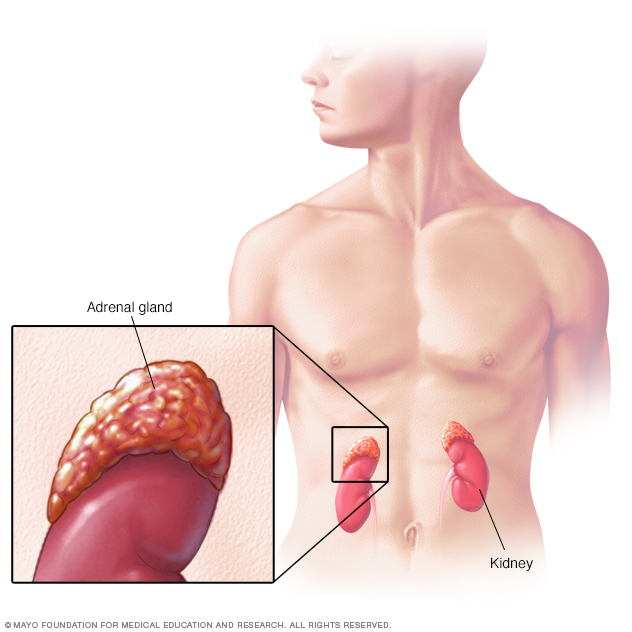Overview
Benign adrenal tumors are masses that aren't cancer. They form in the adrenal glands. The adrenal glands are part of the endocrine system. These glands make hormones that send messages to nearly every organ and tissue in the body.
There are two adrenal glands, one above each kidney. Each gland has two types of tissue: the cortex and the medulla. Benign adrenal tumors that grow in the cortex are called adrenal adenomas. Those that grow in the medulla are called pheochromocytomas (fee-o-kroe-moe-sy-TOE-muhs).
Most benign adrenal tumors cause no symptoms and don't need treatment. But sometimes these tumors make high levels of some hormones that can cause problems. Hormones from the cortex control metabolism, blood pressure and certain body features, such as hair growth. Hormones from the medulla control the body's response to stress.

Symptoms
Symptoms depend on whether the tumor makes hormones, what hormone it makes and how much it makes. But many benign adrenal gland tumors don't cause symptoms because they don't make hormones.
The most common type of benign adrenal tumor, called adenoma, comes from the adrenal cortex. This type of tumor might cause symptoms such as:
- Weight gain.
- Easy bruising.
- High blood pressure, also called hypertension.
- Diabetes.
- Depressed mood.
- Tiredness.
- Muscle weakness or cramping.
A type of benign adrenal tumor from the medulla is called pheochromocytoma. It might cause the following symptoms:
- High blood pressure, also called hypertension.
- Fast heartbeat.
- Sweating.
- Tremors.
- Headache.
Causes
The cause of benign adrenal tumors often is not known.
Risk factors
The following might raise the risk of developing a benign adrenal tumor:
- A family history of benign adrenal tumors.
- Certain syndromes passed through families, called genetic syndromes, that make benign adrenal tumors more likely.
- A history of having an adrenal tumor surgically removed.
Diagnosis
Benign adrenal tumors often are found by chance on imaging that's done for another reason. A healthcare professional then looks at how likely the tumor is to be cancer and whether it's making too much hormone.
Tests
Along with a physical exam, a healthcare professional runs blood and urine tests to see if the tumor is making too much hormone. The tests also show which hormone the tumor is making.
Imaging tests can give more details about the tumor. They can show whether the tumor is at high risk of being a cancer, which is rare.
Imaging tests might include:
- CT scan. This type of scan takes a series of X-ray images from different angles and makes them into cross-sectional images.
- MRI. This type of scan uses radio waves and a magnetic field to make detailed images.
- M-iodobenzylguanidine (MIBG) imaging. This type of scan uses a radioactive compound that's injected into the body. Some adrenal gland tumors take up the compound. The image can show tiny amounts of the compound that are picked up by a tumor.
- Positron emission tomography (PET). This type of scan also can detect radioactive compounds taken up by a tumor.
- Ga-DOTATATE PET scanning. This newer imaging test isn't widely offered. Ga-DOTATATE PET scanning is done along with either a CT scan or an MRI. This type of test is good at finding tumors of the endocrine system, such as benign adrenal tumors.
Treatment
Benign adrenal tumors often don't need treatment. Treatment depends on how likely the tumor is to become cancer. Treatment also might depend on whether the tumor is making hormones, the type of hormone it makes and how much it's making.
Treatment for small benign adrenal tumors that aren't making hormones might involve watching the tumor. There might be repeat imaging tests 3 to 6 months after diagnosis, and then every one or two years. Watching also might involve testing hormones every year for five years.
If the tumor is getting bigger or causing symptoms, the symptoms might be treated with medicines. Medicines also might be used to treat symptoms such as high blood pressure before surgery.
Surgery to remove the adrenal gland, called adrenalectomy, might be used to treat a benign adrenal tumor. The surgery may be done laparoscopically if the tumor is small and not likely to be cancer.
Preparing for an appointment
You might start by seeing your primary healthcare professional. Or you might be sent to a specialist in the endocrine system, called an endocrinologist.
Here's some information to help you get ready for your appointment.
What you can do
When you make the appointment, ask if there's anything you need to do in advance, such as not eating or drinking before a certain test. Make a list of:
- Your symptoms, including any that don't seem linked to the reason for your appointment, and when they began.
- Key personal information, including major stresses, recent life changes and family medical history.
- All medicines, vitamins or other supplements you take, including doses.
- Questions to ask your healthcare professional.
Take a family member or friend along, if possible, to help you remember the information you're given.
For a benign adrenal tumor, some questions to ask include:
- What's likely causing my symptoms or condition?
- Other than the most likely cause, what are other possible causes?
- What tests do I need?
- How likely is it that the tumor will become cancer?
- What's the best course of action?
- I have other health conditions. How can I best manage them together?
- Are there restrictions I need to follow?
- Should I see a specialist?
- Are there brochures or other printed material I can have? What websites might be helpful?
© 1998-2025 Mayo Foundation for Medical Education and Research (MFMER). All rights reserved. Terms of Use


